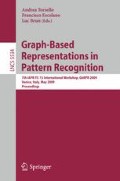Abstract
The efficiency of a pyramid segmentation approach mainly depends on the graph selected to encode the information within each pyramid level, on the reduction or decimation scheme used to build one graph from the graph below, and on the criteria employed to define if two adjacent regions are similar or not. This paper evaluates three pairwise comparison functions for perceptual grouping into a generic framework for image perceptual segmentation. This framework integrates the low–level definition of segmentation with a domain–independent perceptual grouping. The performance of the framework using the different comparison functions has been quantitatively evaluated with respect to ground-truth segmentation data using the Berkeley Segmentation Dataset and Benchmark providing satisfactory scores.
Access this chapter
Tax calculation will be finalised at checkout
Purchases are for personal use only
Preview
Unable to display preview. Download preview PDF.
References
Robles-Kelly, A., Hancock, E.R.: An Expectation–maximisation Framework for Segmentation and Grouping. Image and Vision Computing 20, 725–738 (2002)
Wertheimer, M.: Ǔber Gestaltheorie. Philosophische Zeitschrift für Forschung und Aussprache 1, 30–60 (1925)
Arbeláez, P., Cohen, L.: A Metric Approach to Vector–valued Image Segmentation. Int. Journal of Computer Vision 69, 119–126 (2006)
Marfil, R., Molina-Tanco, L., Bandera, A., Rodríguez, J.A., Sandoval, F.: Pyramid Segmentation Algorithms Revisited. Pattern Recognition 39(8), 1430–1451 (2006)
Marfil, R., Molina-Tanco, L., Bandera, A., Sandoval, F.: The Construction of Bounded Irregular Pyramids with a Union–find Decimation Process. In: Escolano, F., Vento, M. (eds.) GbRPR 2007. LNCS, vol. 4538, pp. 307–318. Springer, Heidelberg (2007)
Haxhimusa, Y., Glantz, R., Kropatsch, W.G.: Constructing Stochastic Pyramids by MIDES - Maximal Independent Directed Edge Set. In: Hancock, E.R., Vento, M. (eds.) GbRPR 2003. LNCS, vol. 2726, pp. 35–46. Springer, Heidelberg (2003)
Meer, P.: Stochastic Image Pyramids. Computer Vision, Graphics and Image Processing 45, 269–294 (1989)
Jolion, J.M.: Stochastic Pyramid Revisited. Pattern Recognition Letters 24(8), 1035–1042 (2003)
Haxhimusa, Y., Glantz, R., Saib, M., Langs, G., Kropatsch, W.G.: Logarithmic Tapering Graph Pyramid. In: van Gool, L. (ed.) DAGM 2002. LNCS, vol. 2449, pp. 117–124. Springer, Heidelberg (2002)
Haxhimusa, Y., Kropatsch, W.: Segmentation Graph Hierarchies. In: Proc. of IAPR Int. Workshop on Syntactical and Structural Pattern Recognition and Statistical Pattern Recognition, pp. 343–351 (2004)
Luo, J., Guo, C.: Perceptual Grouping of Segmented Regions in Color Images. Pattern Recognition, 2781–2792 (2003)
Huart, J., Bertolino, P.: Similarity–based and Perception–based image segmentation. In: Proc. IEEE Int. Conf. on Image Processing, pp. 1148–1151 (2005)
Martin, D., Fowlkes, C., Malik, J.: Learning to Detect Natural Image Boundaries Using Brightness, Color, and Texture Cues. IEEE Trans. on Pattern Analysis Machine Intell. 26(1), 1–20 (2004)
Martin, D., Fowlkes, C., Tal, D., Malik, J.: A Database of Human Segmented Natural Images and its Application to Evaluating Segmentation Algorithms and Measuring Ecological Statistics. In: Int. Conf. Computer Vision (2001)
Dollár, P., Tu, Z., Belongie, S.: Supervised Learning of Edges and Object Boundaries. In: Int. Conf. Computer Vision Pattern Recognition (2006)
Maire, M., Arbeláez, P., Fowlkes, C., Malik, J.: Using Contours to Detect and Localize Junctions in Natural Images. In: Int. Conf. Computer Vision Pattern Recognition (2008)
Felzenszwalb, P., McAllester, D.: A Min–cover Approach for Finding Salient Curves. In: POCV 2006 (2006)
Author information
Authors and Affiliations
Editor information
Editors and Affiliations
Rights and permissions
Copyright information
© 2009 Springer-Verlag Berlin Heidelberg
About this paper
Cite this paper
Marfil, R., Bandera, A. (2009). Comparison of Perceptual Grouping Criteria within an Integrated Hierarchical Framework. In: Torsello, A., Escolano, F., Brun, L. (eds) Graph-Based Representations in Pattern Recognition. GbRPR 2009. Lecture Notes in Computer Science, vol 5534. Springer, Berlin, Heidelberg. https://doi.org/10.1007/978-3-642-02124-4_37
Download citation
DOI: https://doi.org/10.1007/978-3-642-02124-4_37
Publisher Name: Springer, Berlin, Heidelberg
Print ISBN: 978-3-642-02123-7
Online ISBN: 978-3-642-02124-4
eBook Packages: Computer ScienceComputer Science (R0)

